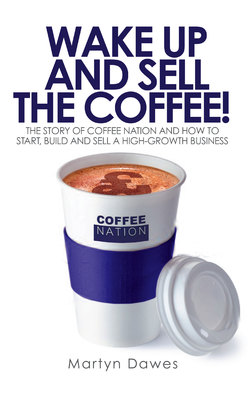Читать книгу Wake Up and Sell the Coffee! - Martyn Dawes - Страница 34
На сайте Литреса книга снята с продажи.
Putting development funding to use
ОглавлениеWith £190k funding now available for proper development and a chairman in place, there were two areas I needed to focus on:
1 Get the offer right – great coffee from easy-to-use machines which were clean, reliable and attractive.
2 Get big customers that could commit to a substantial numbers of sites.
I set to work on the identity of the company first. I met with a small brand and packaging design consultancy in London who had good credentials.
We started with a new brand logo. When they showed me a picture of a cappuccino in a takeaway cup on one side with coffee beans behind and a girl and a guy on the right, I knew instantly this was the logo we should use.
It worked for me because it was more about people (Nation) choosing our product (Coffee) instead of standing in line at a coffee shop. We also came up with a strapline: “Express Yourself”. This was intended to have a double meaning. Be yourself, be who you want to be and press yourself, i.e. self-serve coffee.
The next challenge was to find a robust espresso machine. The machine I had been using was little more than a beefed up home coffee maker. Almost three years earlier I had met a coffee machine company in Minneapolis and they had the perfect machines.
They were big pieces of kit, very sturdy and with easy-to-use touch buttons that we could configure and brand as we wanted. I could see that they would be tough enough to withstand any trading environment. They had an onboard fridge for the milk and no parts to remove for cleaning. I thought this would be much easier for store staff to look after.
I met with their UK distributor in North London and then planned a trip to visit the factory in Seattle to meet their CEO. Those few days in Seattle were the start of a long and successful collaboration for both companies.
We now had the machine we needed so the next task was to develop the shop front, or concession that the machine would sit in. I had learnt that the more space we could take up in a store the more chance we had of attracting customers. We settled on a fibreglass unit 1.5m wide that would be backlit to stand out in a busy store. We had regular and large cups and – just like in a coffee bar – tiny espresso cups. I didn’t expect to sell much espresso but it was the signature product and a mark of authenticity.
There was an integral bin, wooden stirrers, storage inside the unit, an automatic chocolate duster for cappuccinos and even an aroma pump at floor level to pump out the smell of coffee beans into the store. It had to be easy to use for customers, easy to keep clean for staff and easy to work on for maintenance purposes. This unit had to work and look good for at least four years, which was the time period over which we elected to depreciate the installation.
